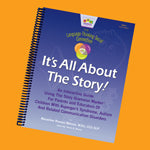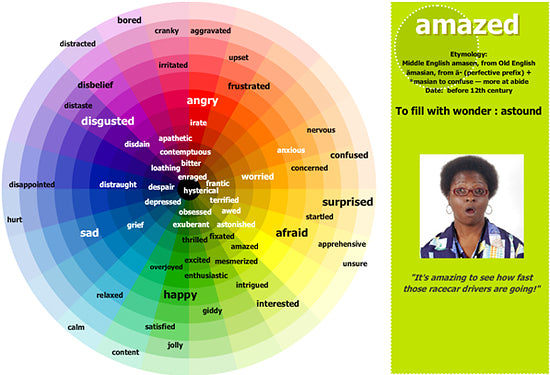Menu
-
- Home
-
About Us
-
The Approach
-
Linking Language & Literacy
-
MindWing Learning
-
Learning Resources
-
SHOP
-
Blog
-
- About MindWing
- Our People
- Contact Us
- Your Account
- Login
-
United States (USD $)

Interactive, Visual Resources to Complement Feelings Instruction (Internal Responses)
by Sean Sweeney January 31, 2011 2 min read
 As stated so well in It’s All About The Story, Book I of MindWing’s Autism Collection, “Tuning into one’s own Feelings as well as the Feelings of Others is extremely problematic to children with autism. The book provides visual flip charts, discussion prompts and an introduction to the Six Universal Feelings (happy, sad, mad, scared, surprised and disgusted), as well as ways to move beyond those Universal categories to more advanced feelings vocabulary--all of these resources give SLPs a great place to start. Finding that starting point- like all vocabulary instruction- can be difficult, especially with a topic as abstract as emotions. To complement the charts and picture book suggestions in It’s All About The Story, here are some resources to make feelings instruction more interactive, visual and accessible.
As stated so well in It’s All About The Story, Book I of MindWing’s Autism Collection, “Tuning into one’s own Feelings as well as the Feelings of Others is extremely problematic to children with autism. The book provides visual flip charts, discussion prompts and an introduction to the Six Universal Feelings (happy, sad, mad, scared, surprised and disgusted), as well as ways to move beyond those Universal categories to more advanced feelings vocabulary--all of these resources give SLPs a great place to start. Finding that starting point- like all vocabulary instruction- can be difficult, especially with a topic as abstract as emotions. To complement the charts and picture book suggestions in It’s All About The Story, here are some resources to make feelings instruction more interactive, visual and accessible.
One fun way to explore the Six Universal Feelings and how feelings can change as a result of Kick-Offs is through comic strips. You can locate all sorts of comics with simple narrative structure and clear character feelings at Comics.com (try Peanuts for a perennial favorite):

You can also make your own comics with simple strip creators like Make Beliefs Comix (as a project with kids or pre-made to analyze with your students). Here’s a silly one I made to illustrate the emotion mad (make sure to print, email or screenshot your work, so you can use it later):

One way to expand vocabulary from the typical “ HAPPY/SAD/MAD” is to refer your students to MindWing’s Feelings Poster™. It is available here - CLICK HERE.
Another great way to make connections to the Universal Feelings and develop vocabulary in context (with reference to nonverbal cues) is with the interactive Emotions Color Wheel.
This resource organizes feelings by color and degree of intensity- with less intense emotions located on the outside of the wheel- and provides an image and quote to go with each feeling!
It is therefore a great way to talk about the nonverbal cues that help us “read” each emotion, as well as a “Kick-Off” that could cause us to feel that way.

Children like looking at snapshots and images, and one way to engage them in feelings discussion is to view some arrays of photos related to feelings. Internet-based stock photo sites offer a great variety of emotion-based professional images that you can browse for free with students. You can of course purchase some images for your own use and keeping, but you can also just search and explore with students (as long as you don’t mind seeing a watermark on the photos as you do so- it really doesn’t get in the way of analyzing the photo). Sites such as iStockphoto have the added advantage of providing an interesting activity to explore social inferencing and perspective taking: What (i.e. what context- character, setting, or kick-off) is making each of these people so cheerful?

This array is from a search of iStockPhoto (on the site, you can mouse over images to enlarge); some other resources you can try include Shutterstock and Veer.
Hope these resources make you feel happy!
Sean Sweeney
Sean Sweeney, MS, MEd, CCC-SLP, is a speech-language pathologist and technology specialist working in private practice at the Ely Center in Needham, MA, and as a clinical supervisor at Boston University. He consults with local and national organizations on technology integration in speech and language interventions. His blog, SpeechTechie (www.speechtechie.com), looks at technology “through a language lens.” Contact him at sean@speechtechie.com.
Leave a comment
Comments will be approved before showing up.
